Wayne C. Allen's Blog, page 25
October 25, 2017
It’s All About Stress
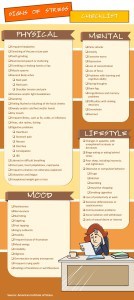
It’s All About Stress — stress in and of itself is not a problem. Chronic stress… that’s another issue!
We’re on the road in Ireland! Then, we’ll be in Spain until mid-January. Love this retired life!

Psst! Hey!
** Want more great writing designed to help YOU to shift your behaviour?
** Want to learn how to find, build or deepen your principal relationship?
** Want to know more about Zen living and being?
First of all, it’s all about stress! Stress is our natural state.
Here’s an example: think about a guy wire on a tent; it’s connected between the tent and a peg hammered into the ground.
The weight of the tent tries to pull the peg inward.
The peg uses physics and earth energy to pull in the opposite direction.
In between the two stretches the thin guy wire, which balances the opposing forces.
Properly adjusted, the forces that would cause the tent to collapse or be torn apart are brought into balance.
OK. So what? Well, doesn’t it strike you that most people are not looking for a balance between competing forces, but rather are looking for “no tension at all?”
To carry my illustration further, let’s assume the peg in the ground is the way things are and the tent represents the winds of change.
Without change, the peg is just a thing poking out of the ground. We can reflect on it and wonder as to its purpose, but there it is, doing, being nothing.
The tent, without support, will actually fall down and blow away. It is actually not a tent, but simply a piece of canvas. It only becomes a tent when put under tension. As it is with all tents. As it is with life. Not change for change’s sake. Not dull routine.
Life is lived fully only under the tension of change.
Thus, there is some truth to the idea that If it wasn’t for my stress, I’d fall apart.
The Flavours of Stress
Canadian Hans Selye, considered the father of modern stress research, defined stress as:
“The non-specific response of the body to any demand made upon it.”
He also said that stress is:
the wear and tear caused by life.
a state manifested by a specific syndrome of biological events and can be both pleasant and unpleasant.
the mobilization of the body’s defenses that allow human beings to adapt to hostile or threatening events.
dangerous when it is unduly prolonged, comes too often, or concentrates on one particular organ of the body.Stress is not:
Nervous tension.
The discharge of hormones from the adrenal glands.
The influence of some negative occurrence.
And entirely bad event.Kenneth W. Sehnert, M.D. Stress/Unstress, pg. 19–20
Now, you might be wondering what all of that means, in lay terms.
Stress is normal, and stress comes in flavours.
There’s distress (what we might call bad stress)
there’s neutral stress (day-to-day stuff that requires a response)
and what Selye called eustress (from the Greek eu — good, as in euphoric (good) feelings) or good stress.
Stress is personal.
You see a building burning and get a pit of your stomach, heavy, scared, “I want to run away” sensation = distress.
A firefighter hops off the truck. “This is my chance to help, to put out the fire, to maybe save someone!!” He feels eustress
A Buffalo, N. Y. TV reporter sees the fire and goes, “Hmm. Another fire in Cheektowaga.” = neutral stress.
That said, the person who is not a firefighter might have a terrible time imagining someone getting turned on by a fire. The firefighter likely thinks she lives an adventure-filled life and that others are “missing something.”
This is because we do not agree about what is stressful, and what is not.
This difference of opinion regarding stress leads to conflict (which, of course, increases our stress.) When we are stressed and others “don’t get it,” we further stress ourselves by saying, “You don’t understand!”
We’re right! They don’t.
There is no one path to stress — there are several:
Traditional fight/flight:
you’re walking along, and a tiger jumps out at you. Its motion is picked up by your eyes, and transmitted simultaneously to the endocrine system and the body.
your body is instantaneously flooded with hormones designed to speed up respiration, minimize bleeding, sharpen the senses, and stop digestion.
Your brain clicks out of thinking mode to reactive mode. This situation requires an instantaneous reaction, not an “Hmm. I wonder what the best way to deal with a charging tiger might be” reaction.
As soon as the threat is over, your body dumps the hormones, and you feel exhausted, sick to your stomach, and soon return to normal.
You might think of traditional fight/flight type stress as the natural form of stress — what the stress reaction was originally designed for. In other words, this reaction was hard-wired into us so that we could deal with life-threatening situations.
The “what if” game: This one starts in the head as worry or obsession.
you’re sitting safely in a chair, yet begin wondering how badly you’ll be mauled if a tiger jumps out at you.
Because the subconscious cannot tell real from fantasy (that’s why we don’t know we’re dreaming until we wake up,) the body begins to respond as if the threat is real, using the fight/flight response described above.
Hormones flood the body, and you feel anxious, wired, and suspicious… you actually start looking for the tiger!
Often, with this approach, the body goes on a low-level alert, and stays slightly stressed. This slightly stressed state is soon accepted as normal.
The idea here is that we are reacting to an imagined (and therefore imaginary) threat. We thus create an endless feedback loop. I imagine I’m threatened, and can’t locate the threat, so I assume I’m simply missing the threat, and keep watching, while all the time saying, “Well, I feel threatened, so therefore there must be a threat.”
The “ouch” game:
you’re sitting in a chair, and feel a pain in your body.
Rather than ask, “What’s up,” you either go into denial, or overstate the pain into a major illness.
In either case, as we do not address the body, the tension at the muscular level is accepted as normal.
In a sense, you might think of your body as a boiler — one with an adjustable relief valve. In the “good old days,” when the valve got tripped, someone went downstairs and looked around, fixed what was wrong, and then had lunch. These days, someone goes downstairs, bangs on the valve, doesn’t look for what’s wrong, and just replaces the check valve with one that goes off at a higher pressure.
And… this keeps happening until the tank explodes.
The “modern medical miracle” game:
There is an expectation that “the doctor” has a pill that will make all of this go away. As opposed to our asking the question, “Why am I creating stress in my life and doing nothing about it?”
Next week, we’ll look at what unresolved, chronic stress does to our bodies and minds.
The post It’s All About Stress appeared first on The Pathless Path.
October 18, 2017
Life and Stress
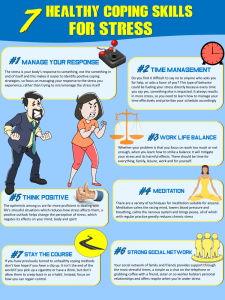
This is post 1 of 1 in the series “Dealing with Stress”
Life and Stress — recent studies have declared that stress is at epidemic levels. This is certainly so with students. What can we do differently?

Psst! Hey!
Want more great writing designed to help YOU to shift your behaviour? Want to learn how to find, build or deepen your principal relationship? Want to know more about Zen living and being? Check out Wayne’s books!
As is quite atypical for me, I’ve sat staring at the computer monitor this morning, waiting for the bluebird of inspiration to arrive. (That’s actually an “Allen” joke — my mom, as she got older, would often stop mid-sentence, sigh, and say, “I forgot what I was saying. It’s like the bird flew out of the room and I have to wait for it to fly back in.”)
Fortunately, I ended up focussing on world events, Trump, and life in general. And that led me to think about stress.
So, that’s where we’re going today, and then for a few extra weeks. I’ve also picked up some resources for dealing with stress, and will be creating a new stress-management group. Most of the resources will be free — a few will require a (cheap!) membership.
I was talking with a friend the other day; his daughter had mentioned feeling the following: 1) tingling face, and 2) weak legs. She called EHealth (a Canadian thing, where you can call for medical advice) and was directed to a hospital. The doc there decided that her symptoms were “stress related.”
I guess that’s a second reason for writing this series.
Anyway, is life really more stressful, and even if it isn’t, (hint: it isn’t!) whatever shall we do with that tingly, numb, confused, scared feeling?
There seems to be a very human tendency to divide and subdivide. I’ve written of this in terms of the west’s penchant to break things apart in order to understand them (the scientific method) — while the east’s tendency is to look at unified wholes (systems thinking.)
The thing is, it’s not either / or. It’s both.

Because… everything contains its opposite.
Wholeness means that we combine what seems to be distinct. It’s only human arrogance that causes us to think that things are separate, anyway. For example, if there was no darkness, we would not be able to understand light. This is the point of the small circles in the yin/yang symbol.
Where all of this comes home to roost for me is how we create “us vs. them” games — this is where stress comes from. In many cases, the “us vs. them” game is “me vs. imaginary me.” But same game, though.
We stress when what we see and what we think we “ought to” see are different.
A simple current example, blown large, is the endless nattering over the current president* of the US of A. I mention him not to stoke the Trumpian ego, but to pick something obvious and overblown.
My background is to be politically left of centre by a fair piece (in Canada, I’m a natural NDP, but tend to vote Liberal strategically.) So, my tendency is to disagree with the Orange One about pretty much everything.
Others I know think he’s right on, and should do more of whatever it is he is doing.
So far, so good. If I can understand that I disagree with both him and his supporters, there may be anger, but there is no stress. If I shift to, “I am right and they are wrong” (“us vs. them”) the ONLY result is that I feel stress.
My indignation changes nothing. My desire for change changes nothing. All I get is stressed. On the other hand, if I make changes in what I am doing (how I am living) to reflect what I say I believe, well… that has some traction.
We don’t exist in a vacuum. Nothing can ever change the fact that the “us vs. them” contains human beings on both sides; we are therefore not so different — as people. But if all that happens is that our focus remains on the differences, nothing will be accomplished.
If the focus becomes what we have in common as citizens of a fractured world — a world in need of unity — then there is the possibility of change.
In our personal lives, this is equally the case. It appears that there is no choice about how we are with each other — people are people. And yet this is very far from being so.
If I turn my focus to conflict — to the things that separate and differentiate us, I will always feel isolated, stressed and scared.
If I focus on the things that we hold in common, the drama seems to drop away.
I see it like this — I am on a walk and the purpose of the walk is to understand myself, while appreciating the journey.
Each step of the way, I have the opportunity to simply walk, observe and be open, or to judge. The judgement can be about anything — the weather, the terrain, my travelling companions. If I choose to focus only on my judgments, I find (although I probably won’t notice) that I am in my head and missing the walk.
And yet, the walk is
all that there is.

Your first FREE Stress Management Bonus!
Here’s your first freebie… a great e-book describing chronic stress. Yours for free, no strings attached!
Click here to go to the Introductory article on our Phoenix Centre Press site! The download link is on that page.
The conflicts and divisions I dream up in my head are convenient when I am running an experiment and I want to isolate something. In science labs, we do this all the time. When I apply is to my life, I simply isolate myself. Surely you have noticed this.
The isolation plays out in a frigidity of sensation, a rigidity in thought and a slowness of step. Suddenly, there is no “walk.” There is just the internal drama — the stories, the games I play with myself. I am no longer present in the walking — I am lost in the garden (or jungle) of my head — where nothing is real.
And a strange thing happens.
I am drawn — pulled — to make the
drama real and the walk the illusion!
How odd.
It would be worth your while to notice your drama-making, and to resist going there.
Stress is always the result of obsession. To repeat, it’s an internal process of comparing mental imaginings to reality, and choosing the imaginings. PLUS, then demanding that others change their being so you can stop feeling bad.
The problem is, they are thinking the same about you! Everybody blaming others for their internal games!
I propose a radical acceptance of the walk,
and a radical resistance of the internal drama.
As you notice a pull toward blaming, distance making, anger, conflict, have a breath and pull back a bit. Wonder why you are making this choice. Examine the self-righteousness that comes with isolating yourself. Give yourself a shake, and come back to the walk.
You might just find that nothing much is really going on, the terrain is interesting and the people surrounding you are once again pretty much like you. You may notice commonalities as opposed to differences.
And then, if you are really, really lucky, you may just notice the essential oneness of it all. And you can settle in and enjoy the walk.
The walk is the walk is the walk. You have no choice about that. How you are and who you are, and how you focus on the walk — that’s your choice.
If you are going to walk (and you are!) choose to let the comparisons and blaming and finger-pointing go, and live out of your integrity.
And the stress begins to fall away… and you can get on with actually doing something with your life…
More to come! Stress reduction is definitely our new topic!
The post Life and Stress appeared first on The Pathless Path.
October 11, 2017
There are no Rules
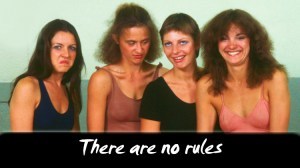
This is post 12 of 12 in the series “Universal Rules”
The Most Important Rule — there are no rules. When it comes to choosing what to do with your life, there are no “universals.” There’s just what works, and what doesn’t.

Psst! Hey!
Want more great writing designed to help YOU to shift your behaviour? Want to learn how to find, build or deepen your principal relationship? Want to know more about Zen living and being? Check out Wayne’s books!
We’ve finally come to the end of our list of Universal Rules… now we need to remember that there are no rules.
What we’ve been looking at these past weeks are ideas or concepts to be considered. Each is nothing more than a suggestion — something to be played with, tested out, evaluated.
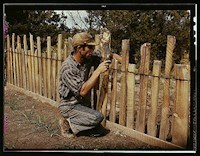 But… this is how I always build doors!
But… this is how I always build doors!The test of the effectiveness of anything is whether it gets the results you want. It’s this same with this list of “rules.”
We’d like to think that there are simple, easy, universal behaviours that always get great results. The joke is, the list we propose consists of things we’re already doing. We’ll say, “This is the way it is,” even when it isn’t.
We tend to miss our own self-serving behaviours, and get ticked off when people won’t go along with us. We say, “It’s in ________’s best interest,” when we mean, “It’s in my best interest.”
It takes a great deal of maturity to see the games we are playing, day in, day out. It takes no effort at all to notice the games others are playing. This is why it’s so important to learn to listen to yourself; to hear yourself as you express yourself.
And then to ask the key question: “What is my goal here? What do I really want?”
Recently, a parent asked her daughter, “If you don’t work out your life, what will people think of you?” It was a part of a “Here’s what you ought to be doing…” lecture. The parent is over-involved, and also self-involved.
The real question she was asking? “If you don’t work out your life, what will people think of ME (as a parent, as a person, etc.)?” Now, that’s an entirely different kettle…
She has a “rule” that the world should look up to her (read, obey her) and it’s predicated upon people doing what she wants them to. Here’s the kicker: nothing wrong with that!
Provided that you also understand that no one cares, and most people are just going to laugh and ignore you.
You would think that by now she would have figured this out: but she hasn’t, because she thinks what she wants should be important to others. As in, that they should do it her way. When most don’t, she blames them!
A far better approach would be to listen to herself, catch herself, and stop expecting others to obey her. Because her stuff is her stuff.
She could have said, “I’m noticing that I’m making myself uncomfortable that you are not making the kinds of decisions about your future that I think you should make. My ego is all tied up in who and how my children are; I’m trying to manipulate you so I can feel better about myself. So, I’m taking a breath, dropping the lectures and guilt trips, and I’m here if you want to talk things through.”
I trust you can see the difference. The latter statement is self-responsible communication, and it owns what is going on for the speaker. Not games, not blame, not “parenting” (badly.) And it offers and ear, not a lecture.
There ought to be a “rule” that all parents communicate this way, eh?
September 27, 2017
Seek solutions, without placing blame
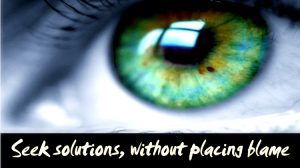
This is post 11 of 11 in the series “Universal Rules”
Seek solutions, without placing blame — amazing how much time is wasted not dealing with issues. Rather than freeze up with blaming, do something!

Psst! Hey!
Want more great writing designed to help YOU to shift your behaviour? Want to learn how to find, build or deepen your principal relationship? Want to know more about Zen living and being? Check out Wayne’s books!
 Tell me what you really think…
Tell me what you really think…Here’s a semi-funny instance from my past, with a couple doing the opposite of this “rule.”
The two were also business partners. One session, she complained that one of their clients acted surly and arrogant when she met with him. She told me at great length about how he “hates women” and “puts them down.” She then said that her husband had a great relationship with the guy.
I said, “So, if your husband gets along with this guy, and you are making yourself angry over the client, why don’t you give the client to your husband, and let him manage the account?”
There was stunned silence.
I continued, “Isn’t that what you guys would do with difficult clients, if you weren’t married to your business partner?”
They both said that this would be exactly what they’d do. If they weren’t married, of course.
I said, “Isn’t it funny that each of you can solve problems at work, but when it comes to issues involving the two of you, who’s “right” always seems to take precedence over actually resolving the issue?”
He shook his head, “Not so funny. We fight about this kind of stuff all the time. Your suggestion simply resolves the issue.”
Parenthetically, this was the point when other couples turned to each other and said, (with grins on their faces,) “Rats! Now we’ll have to come up with something else to fight about!”
You might wonder what’s up here.
Many are the folk who are incredibly successful at work, yet who treat personal issues — and their partners — in ways that, at work, would get them fired. And they swear they are doing it for “love.”
Well, spare me from love, if it requires that I verbally beat up on Darbella, while continually proving her wrong.
Here’s a breakdown of the pattern:
There’s an issue between two people.
With every issue, there are three options:
One is to live with the issue by accepting things as they are (No whining.)
Another option is to solve the issue.
The third option is to find someone to blame.
You wouldn’t think that the third option would be all that popular.
Yet, I often heard, “We have this issue and if only he would admit that it’s all his fault and promise me that he will mend his ways, everything would be fine.”
When I questioned how that would resolve the issue, the person with this “brilliant” suggestion would look at me quizzically, and say, “You just don’t get it. I’ve been trying to get him to accept responsibility for this for years!”
Now, on the surface, this obviously makes sense. Here’s the problem, here’s the one thing we’ve been doing, over and over, that has never worked, and here’s “him,” not taking responsibility for the failure.
Where this falls apart is on the practical level.
Marriage, relationships — and indeed any kind of interpersonal struggle — are the same as any business transaction, or series of transactions.
A successful transaction looks like this: I walk into a store, pick up a Toronto Star and walk up to the counter. After a couple of pro forma pleasantries — typically including “Will that be all?” — I hand the clerk a five dollar bill and she hands me my change. I smile, pick up my paper, and leave.
Successful transactions are also simple, and mostly “impersonal.”
In the same way, every relationship issue is “supposed to” be successfully resolved. Difficulties, however, can arise over our definition of success.
If we go back to the first example, with the misogynist customer, it is clear that the wife was looking for support for her viewpoint, not for resolution. She wanted her husband to agree that the customer was being a jerk, treating her badly, and then to go in and “straighten him out.” He was caught in, “The guy is our best customer. Just suck it up.”
For both, the issue became personal, as opposed to something to be resolved.
I suggested that they treat the issue as a business issue… that they stop using the situation to play the “If you loved me you’d…” game. I asked them to ask a simple, practical question: “What’s the easiest, most efficient way to drop the drama, and keep this account?”
Here’s a more general way of looking at this: in every situation and relationship, there has to be a goal. There are two broad categories of goals: one is very “Zen,” and the other is “ordinary.”
The Zen-ish goal is to have a deep, meaningful and honest relationship, and to resolve issues using elegant solutions.
The ordinary goal is to make everything about proving the other person wrong, getting the other person to accept responsibility for what you are feeling, or being declared the wise and all knowing one who is going to straighten the other person out.
If you apply the ordinary principles to business issues, you can immediately see that the ordinary approach will cause your business to screech to a halt due to finger-pointing.
Thus, a fight centered around “You don’t appreciate all I do around here,” which is met with “You don’t acknowledge how hard I work,” will get nowhere. On the other hand, “I’m really stressing myself out right now, and need a break. Afterwards, let’s sit down and look at effective solutions.” will head in another direction.
Some decades ago I was hired to work with a department of a major Canadian retailer. Unlike many of my corporate clients, the department head actually wanted his people to think for themselves and to make their jobs fun, while at the same time taking complete responsibility for their “areas.”
He was able to “let go” of being the boss, and his “troops” rose to the occasion — the department became the most successful in the company.
The reason the new way of doing things worked was that there was never, ever, any finger pointing and blaming. There were monthly sessions of “what works, what doesn’t,” and when I wasn’t around, endless dialogue and sharing of techniques that “worked.”
Word of our work spread, and he and I were invited into other departments, and we began to achieve similar results. Then, the parent company, (which has since gone bankrupt) replaced the top management with people from another chain. Right after this happened, I got called in to facilitate a meeting between the old and the brand new Vice Presidents, to help with the transition.
The meeting was supposed to last 5 hours. It went 9.
The tension in the room was palatable. When I asked for introductions, I got them, then piles of complaints and blaming. I suggested we spend the first hour getting the anger and blaming off their chests. Tactically, that was a mistake on my part, as I never proposed a framework for what they did want.
No matter what I did, they kept returning to the finger pointing. We spent 9 hours in complaint and blaming mode, only emerging from the mess a couple of minutes at a time. The meeting was a disaster.
That was a long example of how blaming can screw up a business.
In all cases, business and personal, there needs to be an agreement that we are seeking a solution, as opposed to placing blame. And then, all of the dialogue must be directed to problem solving and solution building. If the conversation keeps slipping back to blaming and trying to embarrass the other person, there will never be a solution.
This week, listen to how you talk to the people in your life. Are you blaming? Are you acting all-knowing and superior? Are you trying to make the other person responsible for your life, your feelings?
If so, knock it off, just for a week. Accept responsibility for who you are and where you are, including where you are stuck. Cut your partner some slack, and invite him/her into dialogue about what you want out of the relationship or situation. Then, problem-solve toward solution, never toward blame.
See what happens!
The post Seek solutions, without placing blame appeared first on The Pathless Path.
September 20, 2017
Wait Patiently

This is post 10 of 10 in the series “Universal Rules”
Wait Patiently — No Answer Comes Before its Time — patience, indeed, is a virtue. Be willing to wait with anticipation and joy.

Psst! Hey!
Want more great writing designed to help YOU to shift your behaviour? Want to learn how to find, build or deepen your principal relationship? Want to know more about Zen living and being? Check out Wayne’s books!
Today’s concept has a lot in common with this old saw:
“Where did you find the book you were looking for?”
Answer: “The last place I looked.”
And it’s also part and parcel with the old joke:
A guy is on his hands and knees under a streetlamp, looking for something.
A friend walks by and asks him what he’s looking for.
“My keys. I dropped them.”
His friend squats down and helps him look.
After an hour, neither has found the missing keys.
The friend says, “Are you sure this is where you lost them?”
“No, I dropped them over there, on my porch.”
Exasperated, the friend says, “We’ve just wasted an hour! Why are we looking over here?”
Nonplused, the man says, “Why, because the light is better over here!”
No answer CAN come before its time, because we don’t recognize it as the answer until we are ready to hear it.
And as the joke reminds us, it is of course easier to search for answers in the light of what we know, rather than to risk the fearful darkness in order to find the missing key.
So to speak.
 Maybe if I glare at it…
Maybe if I glare at it…I was reading a Zen book the other day, which is a “lovely to look at” kind of book. It’s called, Zen in 10 Simple Lessons.
The book emphasises the simplicity of the principles of Zen, of which are few indeed. As a matter of fact, Zen can be boiled down to “simply sitting.” Yet within that simple sitting is the patient exploration of the space between breaths… or the contemplation of a koan, (a riddle)… or a day spent in reflection in a Zen Garden.
At the same time, each day spent in contemplation is complemented by “chopping wood and carrying water.” Everyday Zen, every day.
One does this for many years, for a lifetime, despite knowing that there is only a possibility that enlightenment will come.
I remember watching the TV show “Kung Fu” as a teen, and seeing the child version of Kwai Chang Caine standing at the gate to the Shaolin Monastery. He waited for days before he was admitted — a clear test of his patient resolve. I’m still amazed with that series, and with the essentially slow pace of it…
…because patience — or “waiting patiently” — grates on western nerves.
Another way of thinking about our idea for the week might be this:
No Answer Comes Before it is Earned.
Many people get quite good at the techniques required for “just sitting,” and yet peace of mind eludes them. We then understand that one does not find wisdom by learning a technique. Wisdom is found in the “not knowing” — in the gaps between each breath.
In the west, there is an expectation that we have the “right” to what we want, and the expectation is that whatever it is should come quickly and preferably painlessly. People do not want to hear that they have to wait and practice and focus and then “sit and breathe” for a while.
They have not developed the skill of patiently waiting, while living out each day fully and completely.
No, this is not a popular thing. And especially it’s not popular because most people have already figured out the answer they want to receive.
They are not happy when the answer is: “There is no answer.”
This is one of those difficult to penetrate concepts. Let me try it this way. What if I adopt two concepts and live them for a while (perhaps a decade or two.)
Concept 1 = there are no answers.
Concept 2 = (from last week) take nothing for granted.
What this might mean, say, in a relationship, is:
Concept 1: Nothing in this relationship actually means anything other than whatever meaning I give it, so I can please myself, anger myself, bore myself, and emphatically I can learn about myself, or not. And none of that will have anything to do with the other person.
Concept 2: If I do not cling to the other person, I can engage with the other person as fully as I choose to.
In other words, whatever I am going to learn about myself in the relationship is directly proportional to my letting go of expectations and clinging.
And this is so with everything.
Answers come precisely at the point when we stop clinging to our need for them.
Solutions materialize in the living out of life, not in avoidance. (That’s the meaning of “chop wood, carry water.” It’s about answers coming in the midst of life, not out of special circumstances, timing, or “being special.”)
You can’t force an answer, and you can’t make an answer conform to a pre-conceived notion of what it ought to be. Answers come when you get out of their way, while living your life fully in the interim.
This week, have a breath and let go of chasing after what seems to resist showing up. Instead, sit in the moment. Let the moment expand, without judgement. And see if the answer arrives, in it’s own time. Not as a goal to be sought, but as an unfolding of your experience, moment by moment.
The post Wait Patiently appeared first on The Pathless Path.
September 13, 2017
Take Nothing for Granted

This is post 9 of 9 in the series “Universal Rules”
Take Nothing for Granted — we assume that, because we believe something, that’s what will always be true. Not so! What is, is.

Psst! Hey!
Want more great writing designed to help YOU to shift your behaviour? Want to learn how to find, build or deepen your principal relationship? Want to know more about Zen living and being? Check out Wayne’s books!
Just a quickie note that our time in Costa Rica is coming to a close — we’re on the move again. Thanks to all of our Costa Rican friends for a great 5 months. See you in April!
OK, so… “Take Nothing for Granted” has a plethora of meanings. I’m thinking I’ll tackle two of them, but this might change by the end. So, don’t take for granted that there will only be two…
September 6, 2017
Pay Attention and See the Violets at Your Feet
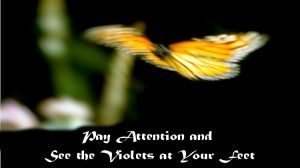
This is post 11 of 11 in the series “The Myths Series”
Pay Attention and See the Violets at Your Feet–it’s really important to look around and see what’s actually going on. You’ll be amazed!

Psst! Hey!
Want more great writing designed to help YOU to shift your behaviour? Check out Wayne’s books!
This expression comes from a story I wrote and included in my first book, Stories from the Sea of Life. (You can have a free digital copy by subscribing for our Phoenix Centre Press Mailing List)
Here’s the story:
In 1992, we bought our first dog, a lovely Australian Shepherd. (Her name, by the way, is Nishka. Her name is short for “Nishkamakarma,” which is Hindu for, “Do your duty, with faith in God, without attachment to the result of your action.” I have a poster of this word hanging in my office.) But I digress.
Nishka spent the Winter of ’92 doing what dogs in Canada do. She pooped on the snow. It melted in and got covered over with more snow. Come Spring, I went out to our backyard in my duck boots, with shovel in hand. I wandered around, and was amazed at the twigs, branches, paper, wrappers and poop that seemed to be everywhere. In fact, I calculated that our four-month winters are composed of 120 days. That means between 120 and 240 piles of poop. What a concept. But while thinking of this, I was looking around. As I looked closer, poking out of the grass was a riot of little, purple violets. I was transfixed, even as I picked up the poop.
Life may provide us with poop to shovel, but if we choose to look around, there is also beauty, order and wonder all around. As any farmer will tell you, what’s poop to one person is fertilizer to another.
 Some day… my prince…
Some day… my prince…I’m thinking about how often people sigh and tell me about how hard their lives are — they then describe, longingly, how things are going to get better “some day.” You could say that they are living their lives in the future, and happiness is something that they never seem to “catch up to.”
What’s funny about all of this is that, as I regularly write, there is nothing “real” about any of the stories we tell ourselves, including happiness stories, whether they are in the present or the future. Our life stories are just a drama we invent. And if this is so, and I think it is, the solution to such fantasy is simple: We need to begin to notice the violets at our feet.
I once had a clients who was 58 — he told me he’d never been happy. I sent him home with an assignment — to open his eyes on the drive home, then go to his den and really listen to some music.
The following week he came in with a really confused look on his face. He hadn’t had a huge epiphany; he had, however, noticed a sunset, really heard a few conversations and lost himself in “Phantom of the Opera.”
Mystified, he asked what had happened.
I joked, “You’ve entered the Twilight Zone.” Then, “What happened was that you simply noticed what was there all along.”
Violets.
Notice that I am not saying that all of his problems, dramas and existential reality ceased to exist. All of that is there too, in living colour. It’s the dog poop in all of our stories. The essential and often missed fact is that the poop is not the whole story, nor even an interesting part of the whole story.
The poop is the background noise.
You have to get this. We are nothing more than what we focus on. At a scary moment, I can condition myself to miss the moment by focusing on the past or the future. Or, at that same “fearful moment,” I can open my eyes. Poof, there is stunning beauty, and a grace filled universe.
A friend recently asked me what I do when “sitting” with dying people. I suggested she read Ram Dass’ Compassion in Action & How Can I Help?
I described what I call simply sitting. It’s simple. I sit and I breathe and I make physical contact. I talk, but only a little. Mostly, I just hang out and stay present.
When my mom was dying, I had an opportunity to do this. She had her last stroke on a Friday, and she died early Sunday. On the Friday she was semi-conscious, and I sat on the bed and stroked her head and kissed her and told her that I loved her; that it was OK, that she could let go — that we’d miss her, and that we’d be OK.
As I did this, I watched her relax, and then sink into a coma. I sat with her and repeated the words the next day, and made contact and breathed, and blessed her and her life.
Her death was “uneventful.” No drama, just a passing and a flowing away. While I grieved and still miss her, the essential beauty and calmness of that final sharing was the result of letting go of her — simply sitting — and avoiding story-telling, clinging and “awfulizing.”
Letting go of past and future dramas allows us to be in the moment and fully present, and in this, no matter what the circumstance, to see the violets. There is great beauty in birth, life and death — in all of life.
Breathe, my friends, and open your eyes and ears and, just for a while, close your mouth. See with the expectation of truly seeing what you’ve been missing. Do not deny the existence of “poop,” but rather accept its presence and “reality” nearby. Shovel it, clean it up, but don’t cling to it.
When you breathe and “truly see,” I guarantee you will be flooded with sunsets, with the words and presence of others, and hear music beyond belief.
And violets.
Everywhere.
As you “just sit.”
Namaste.
The post Pay Attention and See the Violets at Your Feet appeared first on The Pathless Path.
September 2, 2017
One Thing at a Time
This is post 8 of 8 in the series “Universal Rules”
One thing at a time — be willing to fully invest your time and effort on… one thing at a time

Psst! Hey!
Want more great writing designed to help YOU to shift your behaviour? Check out Wayne’s books!
Let’s get straight to the point — hyperactivity, like inactivity, is designed for one purpose — to avoid change. In other words, getting really busy is a way to take anything seriously.
 Spinning in place
Spinning in placeWhile I could make this case in every area from house cleaning to rocket science, let’s use relationships issues as an example. The overactive types say, “There are so many things wrong that I don’t know where to start.”
Get it?? Can’t start, because… too busy… having too many reasons… to start
One client presented the following long list:
his wife was angry all the time
his wife “always” fought with their 21-year-old daughter
his wife “always” fought with friends and neighbours
his wife tried to control his thoughts and actions
he had serious physical complaints of the lower g/i variety
the family barely supported themselves on a disability pension
he had a rough relationship with their daughter — curfew, cleanliness, etc.
The client concluded, “See why I’m sick all the time? How can I possibly deal with all of that?”
It’s not unusual for clients to want the therapist to agree with their self-diagnosis of helplessness. Usually it’s a fleeting thing–most clients quickly “get it” that they can actually change. Occasionally, however, all the client wants is another person to add to their list. “Not only do I have all these issues, now I have to be in therapy!”
Prior to therapy, the client likely whined to friends–for years!–and probably heard endless varieties of “You poor thing! What a mess! I’ve never known anyone with problems like yours!” After a while, this “odd form of praise” isn’t enough; the client decides he or she wants to hear the same message from a professional.
I, however, was never very good at telling people they were hard-done-by. Surprised?
But back to the client with the list.
Me: (I made a Bodywork observation) “Gastrointestinal problems can be about holding on to your shit… like how you hold on to your problems, as opposed to dealing with them.”
The client looked confused. Confusion is another good tool to stay stuck.
Me: “On the surface it looks like the majority of your problems are caused by your wife, right?”
He agreed.
Me: “I’ll bet you’ve spent years trying to get her to change each and every specific behaviour you choose to upset yourself over.”
Him: “Yes! Years! And she refuses to change. Wait a minute! Behaviours I choose to upset myself over???”
Me: “Well, who did you think was upsetting you? Besides, how come you think it’s your job to sort out your wife?”
Him: “Well, someone has to do it. I mean, she yells at the neighbours and fights with our daughter!”
Me: “What does your daughter do when her mom yells?”
Him: “She laughs and walks away, or she fights back and walks away… but surely my wife must be damaging her.”
Me: “Does your daughter appear damaged? Are your neighbours damaged?”
Him: “No… they just don’t have much to do with her.”
Me: You, on the other hand, seem to be damaging yourself over all of this… and you’re doing a good job of it.”
I think you get the point.
The neat thing about this story is that my client “got it” in one session. He learned to deal with his relationships in a new way. When his wife (or daughter) got angry, he disengaged, and said, “When you calm down, if you want to talk about it, I’ll listen. I’m not doing “fixing” anymore.”
When she said, “Why did your daughter stay out all night?” he would say, “I haven’t a clue. All I could give you is my opinion. If you’re curious, go ask her.”
In short, my client realized one important thing: all he could ever be responsible for is his own behaviour. He learned to deal directly with his own emotions, while refusing to get caught in the drama of others.
As an aside, one time he walked away from a mother / daughter verbal battle. He wondered if I was off the mark in my suggestion that he walk away, as they were yelling so loudly and rudely at each other. Surely, he thought, he should have gotten into it too. But… good for him… he stuck to his guns.
45 minutes later he walked into the den. Mother and daughter were curled up on the couch together, watching TV.
Remember: One thing at a time!
Long illustration, short wrap up. Take a look at how you “complex-ify” your life. Notice how easy it is to create a long list of complaints about a situation. Notice the difference between, “My partner and I don’t seem to communicate well,” and a long list of seemingly unrelated irritants. Look to simplify your list by finding the common themes.
If there are still several things on your list, put them in order of seriousness or priority and deal with #1, and only #1. Recognize that we cannot deal with several, a few, or even two issues at the same time.
Drop your habit of fighting by dragging in “the list” of past issues. Stick to one thing, and take it to a logical stopping point before picking up the next thing.
You now know how to actually accomplish something.
The post One Thing at a Time appeared first on The Pathless Path.
August 26, 2017
If You Say It’s Impossible, It Is
This is post 10 of 10 in the series “The Myths Series”
Synopsis: If You Say It’s Impossible, It Is — what we tell ourselves is the most important factor regarding shifting behaviour.

Psst! Hey!
Want more great writing designed to help YOU to shift your behaviour? Check out Wayne’s books!
 See? It will too fit!
See? It will too fit!I don’t think I’d have any trouble at all “selling” the validity of today’s topic
We all know that, to put it colloquially, “Everything is impossible… until it isn’t.” Everything you see around you was yet-to-be-invented at some point in history. Every social convention was, at some point, “born.” Nothing is real until it’s discovered and brought into being.
We know this.
Problems arise when we move from the realm of physical reality to the individual, personal realm. When the topic is “me and my behaviour,” we forget that life is all about flux and change and choice, and we set our minds in concrete.
It’s all “I can’t do that.” “It’s impossible.” “It’s not in my nature; I am how I am.”
Now, for sure, each person has his or her own “impossible” list. This stuff is hard-wired in. And it leads to repetitive, dysfunctional behaviour.
Yet, we declare ourselves to be incapable of doing something differently. Even worse, because we live in an era of “being a victim,” we want an exemption from responsibility for our choice not to change while “blaming” all and sundry.
The hardest work I do is finding the language that will persuade my readers (both of my blog and readers of my books) to actually start listening to themselves; and once they hear what they are saying, to choose to let go of what they are telling themselves.
Better choices are simply that — choices. Yet, to make a better choice, I first have to understand that I have options. If I think that certain things are beyond me, that thought precludes my acting in a different way.
For example, one I hear a lot is, “I’m working on myself.” Or, “I’m finding myself, getting to know myself.” Sounds good, right?
Nope. It’s based upon the erroneous belief that I have to do a long series of “somethings” before I can shift my behaviour. The fixed belief is, “I’m broken.” The erroneous belief is, “See? I’m taking time (4 years, perhaps???) to figure myself out; eventually I’ll start living my life differently.”
If You Say It’s Impossible, It Is. If you say it will take time, that’s just a polite way of saying it’s impossible.
Thank god it didn’t happen often, but I did have a few clients who came for therapy for only one reason. They wanted me to confirm just how stuck they were. They’d come in with some tale of woe and they’d have an excuse for not attempting any option I’d point them toward.
They were in therapy for only one reason: to have someone to witness how sad, pathetic, and hopeless their life was. They wanted to pretend that doing therapy was “progress,” despite the fact that they had no intention of acting differently.
 “You just don’t understand!”
“You just don’t understand!”Here’s an example: I worked with a client whose marriage had ended, and she had moved back in with her mom and dad. She had never gotten along with them, and she especially did not get along with her father. He picked fights with her, and endlessly told her he thought she was irresponsible.
Despite knowing what he thought of her, she told him each of her thoughts and plans, hoping for his blessing. Each time, as he had always done, he shot her plans down. She’d get defensive and angry. He’d call her a baby.
She came to therapy, she told me, so that I would agree that her father was a self-righteous a**-hole. She was certainly honest about her motivations!
I wondered aloud, “And even if that is so, how will that help you to do your life differently?”
She’d sigh, and say, “You just don’t understand!”
As time went by, it became crystal clear that all my client wanted from therapy was for me to agree that she, at age 39, was the helpless victim of a self-righteous father. She refused to consider any alternative descriptions or behaviours.
One time, I asked her, “Why do you need to get your father’s permission to arrange for a ride to work?” She shook her head ruefully and said, “When he doesn’t support me, I feel miserable.”
I said, “First of all, you’re 39, and second, you know that he always disagrees with you or criticizes you; so why ask?”
Reply: “Because he’s my father.”
She wouldn’t allow for the possibility that 39-year-olds do not need their father’s permission to go to work.
Her belief allowed her to feel normal (normal, for her was miserable.) It also allowed her to abrogate responsibility for how her life was going. She believed, “I am the helpless victim of my father, and also of all the men I’ve been with. They make me miserable and never support me. There is nothing I can do about it, and even my male therapist doesn’t get it.”
–“If you say it’s impossible, it is.”
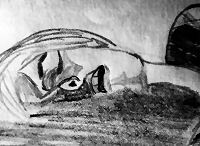 No, really! I don’t feel a thing!
No, really! I don’t feel a thing!Another story, with a positive outcome. It’s about a long-term client who had lots of relationship and sex issues. For several sessions, we talked about her sex drive… or more precisely, her story about not having one.
One day, she said, (and I love this line,) “I just don’t have the sex gene.”
I asked her to explain. She said that sex was dull and boring and that she never got excited, let along had an orgasm or ten. She then detailed some really rough sexual experiences from her teens, and finished by describing her feeling of being pressured to “put out” by her “over-sexed husband.”
Then, almost without drawing a breath, she described a recent “topless-and-touching” escapade she and her husband had with another couple. I asked her how that was for her. She turned red, started squirming on the couch, and said that it had been a big turn on.
I asked, “How does that fit in with your story about lacking the sex gene?”
She looked at me blankly, then said, “Well, this was different… I never get turned on!”
And she refused to discuss it further.
A month or so later she told me she didn’t like porn, and that her husband did. She’d get pissed off at him for watching. “That stuff is such a turn off.”
I suggested she buy some porn DVDs (her choice) for an Xmas present for herself and her husband. She did, but wouldn’t discuss her reaction to watching.
Some months later, she mentioned that she was the proud owner of a satellite TV. She said that she’d been channel surfing and had found a porn channel and had watched several. I asked her how that had been for her.
Again, she turned red, started squirming on the couch, and said that it was a big turn on.
I said, “Tough admitting you’re sexual, eh?”
“Me?” More blushing and squirming.
“What are you feeling right now, as you think back and remember the movie?”
Even more squirming. “Turned on!”
“I guess you tripped over your sex gene.”
It was impossible, until it wasn’t. She owned her “turned-on-ness, and soon was enjoying both sex and orgasms.
You see, dear hearts, nothing is as it appears to be. All that’s “up” for you is whatever story you are telling yourself. If you tell yourself that you have no options, or “worse” if you tell yourself that you are the helpless victim of another person — or of your circumstances — or of “your genes,” that will be enough to keep you stuck in your story.
On the other hand, if you look at what you are telling yourself, and then apply the “utility question,” (“How is this thought, and my current behaviour, working for me?”) you can begin to gently let go of the beliefs and behaviours you are troubling yourself over.
The hardest, most adult thing we can do is to let go of the beliefs that limit us. And the biggest one to get rid of is “blaming.” Blaming others is the clearest indicator of immaturity, and one of the hardest to get rid of.
You have to get rid of it anyway.
This week, ask yourself the utility question, and remind yourself that you don’t have an eternity to sort your life out. Own who and where you are, and own your “impossibilities.” Loosen your grip on them and make them “improbabilities,” (so you don’t scare yourself.
August 19, 2017
Look Wide, Focus Narrow
This is post 9 of 9 in the series “The Myths Series”
Look Wide, Then Focus Narrow — learning to shift your focus means you automatically see a “bigger picture”

Psst! Hey!
Want more great writing designed to help YOU to shift your behaviour? Check out Wayne’s books!
Just a note! More than 2000 copies of my e-books were downloaded during last weekend’s FREE giveaway. If you downloaded one or more, consider leaving a review on Amazon! It really helps!
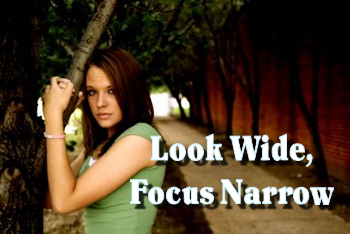
Not long ago, I was rooting around in some old photos, and I came upon one of me playing golf. In Scotland, in 1986. I stopped playing golf many years ago, paradoxically after 2 great years of finally being able to break 90 every time.
Which led me to think of the following: A wide focus or a narrow focus isn’t enough. What we need is a divergent focus. In life as in golf, we need to create multiple foci.
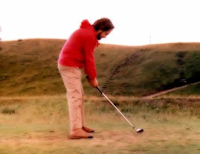 On the moors…
On the moors…Anyway, here are two golf stories.
I started playing golf in High School, and got serious about it during Seminary. One of the guys in my class had been a semi-pro; he’d tried the Canadian Pro Tour, but couldn’t handle the stress and pressure, so he decided to be a Minister. (I’m grinning as I write this–talk about “out of the frying pan, into the fire.”



